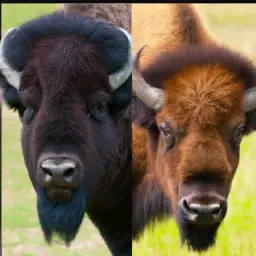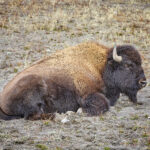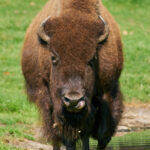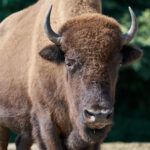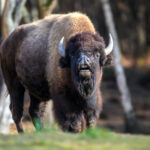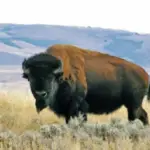Understanding the Terms: Bison and Buffalo
Bison and American Buffalo are two terms often used interchangeably to describe large, hoofed mammals found in North America. However, to truly understand the distinction between these animals, it is important to delve into the historical context of the terms.
Historical context of the terms
The confusion surrounding the names “bison” and “buffalo” can be attributed to the European settlers who first encountered these animals in North America. When they arrived on the continent, they noticed a resemblance between the American Bison and the buffalo found in Africa and Asia. As a result, they referred to the American Bison as “buffalo” due to this perceived similarity.
Common misconceptions about the naming
Contrary to popular belief, bison and buffalo are not the same species. Buffalo typically refers to two distinct species: the African Buffalo and the Asian Water Buffalo. Although they share some similarities with the American Bison, such as a large, stocky build and a humped back, their genetic makeup and physical characteristics differ significantly.
Official terminology and classification
In modern scientific classification, the American Bison is referred to as Bison bison, with two recognized subspecies: the Plains Bison and the Wood Bison. On the other hand, the African Buffalo is scientifically known as Syncerus caffer, while the Asian Water Buffalo bears the scientific name Bubalus bubalis. This official terminology reinforces the distinction between these animals and emphasizes the uniqueness of the American Bison.
Geographical Distribution
Understanding the habitats and geographical distribution of bison and American buffalo is crucial in differentiating these species and observing any overlap or distinctions in their populated areas.
Habitats of Bison
Bison primarily inhabit North America, specifically the Great Plains region that spans from central Canada down to northern Mexico. Historically, they roamed the vast grasslands and prairies of these areas, relying on the availability of open spaces for grazing and access to fresh water sources.
Habitats of Buffalo
The African Buffalo is found throughout sub-Saharan Africa, inhabiting a variety of ecosystems such as savannas, wetlands, and open woodlands. Its Asian counterpart, the Water Buffalo, is predominantly found in Southeast Asia, particularly in countries like India, Bangladesh, and China. These buffalo species have adapted to diverse environments, including swamps, rice fields, and forested areas.
Overlap and distinctions in areas populated
While their habitats may overlap in some regions, such as the grasslands of the Great Plains in North America, bison and buffalo are not typically found in the same areas. The American Bison is indigenous to North America, while buffalo are native to Africa and Asia. This geographic distinction reinforces the separate evolutionary paths these animals have taken.
Physical Characteristics
Examining the physical traits of bison and American buffalo provides further insight into their differences and helps paint a clearer picture of their distinctive appearances.
Physical traits of Bison
Bison have a robust build, with strong shoulders and a massive head. They possess a shaggy coat that varies in color from dark brown to reddish-brown. Both males and females have curved horns, which they use for defense and securing mating opportunities. A prominent hump on their shoulders, formed by muscle mass, distinguishes bison from buffalo.
Physical traits of American Buffalo
American Buffalo, also known as the American Bison, share similar physical characteristics with their European counterparts. They have a large, muscular body covered in coarse fur, ranging in color from dark brown to black. In contrast to the bison, American Buffalo have a hump near their shoulders that is less pronounced.
Key differences in appearance
The key physical difference between bison and American Buffalo lies in their hump shape and size. Bison possess a more prominent hump, indicating their adaptation to harsher climates and the need to store energy reserves. Additionally, the shape and curvature of their horns also vary slightly, with bison typically having thicker and more curved horns compared to American Buffalo.
Bison and American Buffalo Sizes
Comparing the average size of bison and American Buffalo provides further insight into their physical differences and variations.
Average size of Bison
Bison are one of the largest land mammals in North America. On average, they measure between 5 to 6.5 feet tall at the shoulder and can reach lengths of around 9 to 12.5 feet. Adult male bison, known as bulls, can weigh anywhere between 1,800 to 2,200 pounds, while adult females, known as cows, tend to be slightly smaller, weighing around 900 to 1,400 pounds.
Average size of American Buffalo
American Buffalo, or American Bison, are similar in size to their European counterparts. On average, they stand between 5 to 6 feet tall at the shoulder and can range in length from 7 to 11.5 feet. Adult male American Buffalo weigh around 1,000 to 2,000 pounds, while adult females weigh approximately 900 to 1,100 pounds.
Comparing size differences and variations
While their average sizes may be similar, bison tend to have a more substantial build compared to American Buffalo. Bison are generally larger in weight, which can be attributed to their adaptation to colder climates and harsher conditions. However, variations in size can be observed within both species, as factors such as environmental conditions and available resources can influence growth rates and body sizes.
Life Cycle and Reproduction
Understanding the typical lifecycle and reproduction processes of bison and American Buffalo sheds light on their different reproductive strategies and how they adapt to ensure species survival.
Typical lifecycle of Bison
Bison have a relatively long lifespan, with individuals living anywhere between 10 to 20 years in the wild. They reach sexual maturity at around 2 to 3 years old. During the mating season, also known as the rut, males establish dominance and court females using displays of strength and aggression. After a gestation period of around 9 months, females give birth to a single calf. The calf becomes fully independent within a year but remains with the mother’s herd until reaching maturity.
Typical lifecycle of American Buffalo
American Buffalo have a similar lifecycle to bison, with individuals living around 10 to 20 years in the wild. They reach sexual maturity at approximately 2 to 3 years old, with males engaging in aggressive displays to attract mates during the rutting season. After a gestation period of around 9 months, females give birth to a single calf. The calf remains dependent on its mother for about a year before gradually becoming more independent.
Reproduction processes in each animal
The reproduction processes of bison and American Buffalo are fundamentally similar, highlighting their shared evolutionary history. Both species rely on the establishment of dominance among males and engage in courtship rituals to attract mates. Female bison and American Buffalo give birth to a single calf after a similar gestation period. These reproductive strategies ensure the survival and continuation of both species.
Diet
Understanding the diet of bison and American Buffalo provides insight into their feeding habits and food preferences, which can influence their behavior and habitat selection.
Diet of Bison
Bison are herbivores, primarily feeding on grasses and sedges found in their native prairies. They have evolved to be highly efficient grazers and spend a significant portion of their day consuming large quantities of vegetation. Bison are capable of digesting tough and fibrous plant material, allowing them to extract nutrients from their primary food source.
Diet of American Buffalo
Similar to bison, American Buffalo are also herbivores, relying on a plant-based diet. Their feeding preferences vary depending on the available vegetation in their respective habitats. American Buffalo graze on grasses, sedges, and other types of low-lying vegetation found in their native environments. However, they may also consume higher-growing plants when necessary.
Comparison of feeding habits and food preferences
While both bison and American Buffalo share a herbivorous diet, their feeding habits and food preferences may differ slightly due to the variations in their habitats. Bison have evolved to specialize in grazing, which explains their ability to digest tough grasses. American Buffalo, on the other hand, have adapted to a broader range of vegetation types, enabling them to survive in different environments.
Behavior and Social Structure
Observing the social behaviors of bison and American Buffalo provides valuable insights into their respective social structures and how they interact with their own kind.
Social behaviors of Bison
Bison live in hierarchical social structures known as herds, typically consisting of multiple females, their offspring, and a few dominant males. Female bison form the core of the herd and make decisions regarding group movement and resource access. Dominant males, known as herd bulls, actively compete for breeding opportunities and establish dominance hierarchies through physical displays.
Social behaviors of American Buffalo
Like bison, American Buffalo also exhibit social behavior and live in herds. Female American Buffalo form smaller herds consisting of their offspring, with a dominant male known as a herd bull leading the group. This dominant male defends the herd from potential threats and ensures the lineage’s survival by mating with receptive females.
Comparisons in social structure and behaviors
While the social behaviors of bison and American Buffalo are similar, there are subtle differences in their social structures. Bison herds typically consist of larger groups, with females playing a more significant role in decision-making. In contrast, American Buffalo herds tend to be smaller and are led by a dominant herd bull. These differences in social behaviors showcase the adaptations each species has made to thrive in their respective environments.
Conservation Status
Understanding the conservation status of bison and American Buffalo helps shed light on the efforts taken to preserve and protect these iconic species.
Conservation Status of Bison
Bison faced significant population declines in the past due to hunting and habitat loss. However, conservation efforts and reintroduction programs have helped restore their numbers, particularly the Plains Bison and Wood Bison. Today, both subspecies are considered to have a stable population and are categorized as “Near Threatened” by the International Union for Conservation of Nature (IUCN).
Conservation Status of American Buffalo
The American Buffalo, or American Bison, has rebounded from near-extinction and is currently classified as a species of “Least Concern” by the IUCN. Thanks to conservation initiatives and protected areas, such as national parks and reserves, their populations have stabilized and even expanded in certain regions. These efforts highlight the successful conservation measures taken to ensure the long-term survival of American Buffalo.
Efforts taken for each species conservation
Conservation efforts for both bison and American Buffalo have been instrumental in their recovery and preservation. Various organizations, governmental agencies, and indigenous communities have been involved in actively protecting these species and their habitats. Restoration programs, captive breeding initiatives, and the establishment of protected areas have played pivotal roles in the conservation of both bison and American Buffalo.
Cultural Significance
The cultural relevance and historical importance of bison and American Buffalo in Native American cultures cannot be overstated. These animals have played significant roles in the traditions, rituals, and livelihoods of indigenous communities for centuries.
Cultural relevance of Bison
Bison hold immense cultural significance for Native American tribes across the Great Plains. They are seen as sacred animals and are deeply intertwined with traditional ceremonies, practices, and oral histories. Bison provided sustenance, clothing, and shelter for indigenous communities, symbolizing strength, resilience, and harmony with nature. To this day, bison continue to play a crucial role in the cultural identity and spiritual beliefs of Native American tribes.
Cultural relevance of American Buffalo
The American Buffalo, or American Bison, holds similar cultural importance for Native American tribes inhabiting the Great Plains region. These tribes view the buffalo as a symbol of abundance, unity, and connection to the land. The buffalo’s close relationship with indigenous communities is evident in their art, stories, and dances, which celebrate and honor the animal’s historic significance. The American Buffalo remains an integral part of Native American cultural heritage.
Historical importance in Native cultures
Bison and American Buffalo played essential roles in the lives of Native American tribes, serving as a vital source of sustenance, materials, and spiritual meaning. The animals’ availability provided food security for tribes and facilitated the nomadic lifestyle adopted by many indigenous communities. Buffalo hunts were integral communal events, fostering cooperation, communal bonding, and the passing down of traditional knowledge from one generation to the next. The historical importance of these animals in Native American cultures cannot be understated.
Can the Tactics Used to Deal with a Charging Bison be Applied to a Charging Buffalo as Well?
If a bison charges you, it is crucial to know the tactics for dealing with such a situation. However, when it comes to a charging buffalo, can the same tactics be applied? Both animals have similarities, but important differences make it necessary to learn specific strategies for handling each individual encounter.
Summary of Key Distinctions
After exploring various aspects of bison and American Buffalo, it becomes evident that several key distinctions separate these remarkable creatures.
Round up of primary physical differences
Physically, bison and American Buffalo differ in the prominence of their hump, with bison possessing a more pronounced hump on their shoulders. The shape and curvature of their horns also vary slightly. Bison tend to have thicker and more curved horns compared to American Buffalo.
Summary of behavioral differences
Behaviorally, bison and American Buffalo exhibit similar social structures, living in herds led by a dominant male. However, the size and decision-making roles within these herds differ slightly, with bison herds typically being larger and female-driven.
Recap of habitat and geographical distinctions
Geographically, bison are native to North America, particularly the Great Plains region, while American Buffalo are found in Africa and Asia. While their habitats may overlap in certain regions, the ecosystems they inhabit are distinct due to variations in climate and vegetation.
Comparative conservation status
In terms of conservation status, both bison and American Buffalo have made remarkable recoveries from historical declines. Plains Bison and Wood Bison are now classified as “Near Threatened,” whereas American Buffalo are considered a species of “Least Concern.” This difference signifies the successful conservation efforts for these remarkable animals.
In conclusion, bison and American Buffalo may share some similarities in appearance and behavior, but they are distinct species with unique characteristics. Understanding the historical context, geographical distribution, physical traits, sizes, life cycles, diets, behaviors, conservation status, and cultural significance of bison and American Buffalo reveals the intricacies of these remarkable animals. Although they are often referred to interchangeably, recognizing and appreciating the differences between these magnificent creatures enhances our understanding and appreciation of the natural world.

